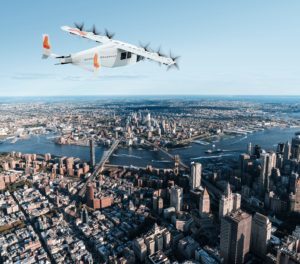
Danish Partnership to Bring eVTOL Transportation to Denmark
by DRONELIFE Staff Writer Ian M. Crosby
A new partnership has been formed between HCA Airport in Odense and Copenhagen Helicopter to establish infrastructure for electric vertical take-off and landing aircraft (eVTOL) to transport passengers between Denmark’s largest cities.
Continue reading below, or listen:
The goal of the partnership is to provide Denmark with a eVTOL prototype by this summer, and afterwards develop one or more vertiports in Odense.

“I foresee that in a few years’ time you can take the light rail to Odense Station and from there take a flying taxi to Copenhagen or other Danish cities. Now is the time to start building a brand new infrastructure based initially on manned flying taxis that fly on green power and contribute to the government’s goal of achieving 100% green domestic transport by 2030,” said HCA Airport Chairman Kim Kenlev. “I see nothing stopping us from flying to cities like Gothenburg, Hamburg or Berlin in the future. Advanced Air Mobility is high on the agenda everywhere, and these cities are within reach of these flying taxis.”
The partnership aims to bring foreign AAM operators to HCA Airport, either through testing and demonstration activities or longer term service and maintenance. HCA Airport is already home to the UAS Denmark Test Center, an internationally recognized drone test site.
“Advanced Air Mobility is based on a new revolution in aviation that says goodbye to fossil fuels in favour of electrification and biofuels – which we already know from the transition from traditional cars to hybrid and electric cars and later self-driving cars. It offers a whole new opportunity to transport people on a daily basis via the skies, while reducing greenhouse gas emissions, reducing noise levels and much more,” said Copenhagen Helicopter CEO Martin Andersen.

Andersen states Copenhagen Helicopter’s calculations indicate that the AAM field has the potential to transport 84,000 passengers per day and remove 120,000 tonnes of CO2 from Danish roads by 2035.
“This could well be the beginning of what will be a whole new way of transporting ourselves and goods in the future. We can see that other countries and cities are already way ahead, and Denmark and Odense must of course also follow this trend. The flying taxis of the future can fly on green power produced by Danish offshore wind turbines, and they can help shift traffic away from the roads,” said Odense mayor Peter Rahbæk Juel. “Funen’s robotics adventure began with some talented engineers from the University of Southern Denmark and a city that dared to think big and take a risk. In the same way, I see this as the first steps towards a new business venture that will hopefully generate jobs, contribute to the green transition and create a whole new way of transporting people.”
Countries such as Korea and Germany already possess advanced frameworks for the introduction of flying taxis. Seoul has plans for regular drone flights across the city as soon as 2025, while in Germany an Airbus-led partnership including Deutsche Bahn, Munich Airport and Telekom is pursuing the implementation of flying taxis between German cities. A total of €86 million has been earmarked for this project over the next three years.
Meanwhile in the US, early in 2022 Boeing invested $450 million in Wisk Aero, a Silicon Valley company in the process of developing a self-flying propeller aircraft.
Read more:
- DRONEII: Flying Cars, Air Taxis, and eVTOLs -the Varieties and Specifications of Passenger Drones [Infographic]
- Drone Taxis are Big Business: The New Ride Share
- EHang: Getting Close to Commercial Applications in Drone Taxis
- Drone Taxi Market Predicted to Grow to More than $800 Million in the next 8 years. Where Will They Fly?
Ian attended Dominican University of California, where he received a BA in English in 2019. With a lifelong passion for writing and storytelling and a keen interest in technology, he is now contributing to DroneLife as a staff writer.
Miriam McNabb is the Editor-in-Chief of DRONELIFE and CEO of JobForDrones, a professional drone services marketplace, and a fascinated observer of the emerging drone industry and the regulatory environment for drones. Miriam has penned over 3,000 articles focused on the commercial drone space and is an international speaker and recognized figure in the industry. Miriam has a degree from the University of Chicago and over 20 years of experience in high tech sales and marketing for new technologies.
For drone industry consulting or writing, Email Miriam.
TWITTER:@spaldingbarker
Subscribe to DroneLife here.







[…] More… […]